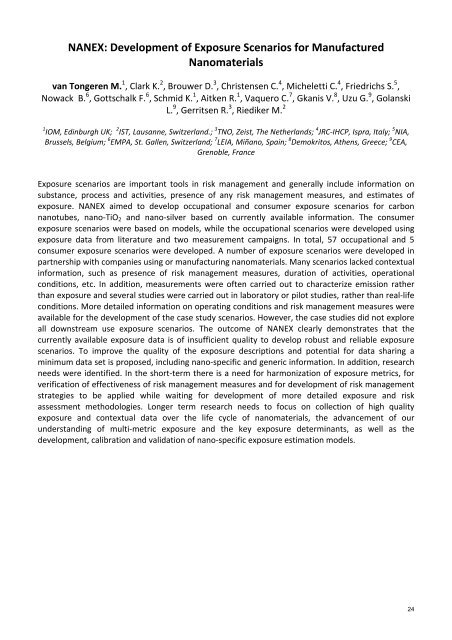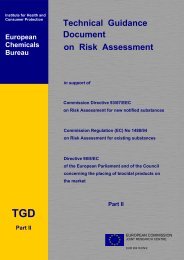Challenges of Regulation and Risk Assessment of Nanomaterials
Challenges of Regulation and Risk Assessment of Nanomaterials
Challenges of Regulation and Risk Assessment of Nanomaterials
You also want an ePaper? Increase the reach of your titles
YUMPU automatically turns print PDFs into web optimized ePapers that Google loves.
NANEX: Development <strong>of</strong> Exposure Scenarios for Manufactured<br />
<strong>Nanomaterials</strong><br />
van Tongeren M. 1 , Clark K. 2 , Brouwer D. 3 , Christensen C. 4 , Micheletti C. 4 , Friedrichs S. 5 ,<br />
Nowack B. 6 , Gottschalk F. 6 , Schmid K. 1 , Aitken R. 1 , Vaquero C. 7 , Gkanis V. 8 , Uzu G. 9 , Golanski<br />
L. 9 , Gerritsen R. 3 , Riediker M. 2<br />
1IOM, Edinburgh UK; 2 IST, Lausanne, Switzerl<strong>and</strong>.; 3 TNO, Zeist, The Netherl<strong>and</strong>s; 4 JRC-IHCP, Ispra, Italy; 5 NIA,<br />
Brussels, Belgium; 6 EMPA, St. Gallen, Switzerl<strong>and</strong>; 7 LEIA, Miñano, Spain; 8 Demokritos, Athens, Greece; 9 CEA,<br />
Grenoble, France<br />
Exposure scenarios are important tools in risk management <strong>and</strong> generally include information on<br />
substance, process <strong>and</strong> activities, presence <strong>of</strong> any risk management measures, <strong>and</strong> estimates <strong>of</strong><br />
exposure. NANEX aimed to develop occupational <strong>and</strong> consumer exposure scenarios for carbon<br />
nanotubes, nano-TiO2 <strong>and</strong> nano-silver based on currently available information. The consumer<br />
exposure scenarios were based on models, while the occupational scenarios were developed using<br />
exposure data from literature <strong>and</strong> two measurement campaigns. In total, 57 occupational <strong>and</strong> 5<br />
consumer exposure scenarios were developed. A number <strong>of</strong> exposure scenarios were developed in<br />
partnership with companies using or manufacturing nanomaterials. Many scenarios lacked contextual<br />
information, such as presence <strong>of</strong> risk management measures, duration <strong>of</strong> activities, operational<br />
conditions, etc. In addition, measurements were <strong>of</strong>ten carried out to characterize emission rather<br />
than exposure <strong>and</strong> several studies were carried out in laboratory or pilot studies, rather than real-life<br />
conditions. More detailed information on operating conditions <strong>and</strong> risk management measures were<br />
available for the development <strong>of</strong> the case study scenarios. However, the case studies did not explore<br />
all downstream use exposure scenarios. The outcome <strong>of</strong> NANEX clearly demonstrates that the<br />
currently available exposure data is <strong>of</strong> insufficient quality to develop robust <strong>and</strong> reliable exposure<br />
scenarios. To improve the quality <strong>of</strong> the exposure descriptions <strong>and</strong> potential for data sharing a<br />
minimum data set is proposed, including nano-specific <strong>and</strong> generic information. In addition, research<br />
needs were identified. In the short-term there is a need for harmonization <strong>of</strong> exposure metrics, for<br />
verification <strong>of</strong> effectiveness <strong>of</strong> risk management measures <strong>and</strong> for development <strong>of</strong> risk management<br />
strategies to be applied while waiting for development <strong>of</strong> more detailed exposure <strong>and</strong> risk<br />
assessment methodologies. Longer term research needs to focus on collection <strong>of</strong> high quality<br />
exposure <strong>and</strong> contextual data over the life cycle <strong>of</strong> nanomaterials, the advancement <strong>of</strong> our<br />
underst<strong>and</strong>ing <strong>of</strong> multi-metric exposure <strong>and</strong> the key exposure determinants, as well as the<br />
development, calibration <strong>and</strong> validation <strong>of</strong> nano-specific exposure estimation models.<br />
24








